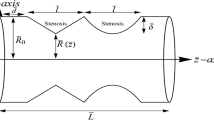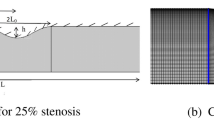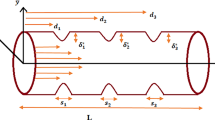Abstract
The pulsatile flow of blood through a catheterized artery is analyzed, assuming the blood as a two-fluid model with the suspension of all the erythrocytes in the core region as a Herschel-Bulkley fluid and the peripheral region of plasma as a Newtonian fluid. The resulting system of the nonlinear implicit system of partial differential equations is solved by perturbation method. The expressions for shear stress, velocity, flow rate, wall shear stress and longitudinal impedance are obtained. The variations of these flow quantities with yield stress, catheter radius ratio, amplitude, pulsatile Reynolds number ratio and peripheral layer thickness are discussed. The velocity and flow rate are observed to decrease, and the wall shear stress and resistance to flow increase when the yield stress increases. The plug flow velocity and flow rate decrease, and the longitudinal impedance increases when the catheter radius ratio increases. The velocity and flow rate increase while the wall shear stress and longitudinal impedance decrease with the increase of the peripheral layer thickness. The estimates of the increase in the longitudinal impedance are significantly lower for the present two-fluid model than those of the single-fluid model.
Similar content being viewed by others
References
P. Daripa and R. K. Dash, A numerical study of pulsatile blood flow in an eccentric catheterized artery using a fast algorithms, Journal of Engineering Mathematics, 42 (2002) 1–22.
M. A. MacDonald, Pulsatile flow in a catheterized artery, Journal of Biomechanics, 19 (1986) 239–249.
D. S. Sankar and K. Hemalatha, Pulsatile flow of Herschel-Bulkley fluid for blood flow through a catheterized artery — A mathematical model, Applied Mathematical Modeling, 31 (2007) 1497–1517.
R. K. Dash, G. Jayaraman and K. N. Metha, Estimation of increased flow resistance in a narrow catheterized artery — A theoretical model, Journal of Biomechanics, 29 (1996) 917–930.
L. H. Back, Estimated mean flow resistance increase during coronary artery catheterization, Journal of Biomechanics, 27 (1994) 169–175.
L. H. Back, E. Y. Kwack and M. R. Back, Flow rate-pressure drop relation in coronary angioplasty: catheter obstruction effect,” Journal of Biomechanical Engineering (ASME Trans), 118 (1996) 83–89.
G. T. Karahalios, Some Possible effects of a catheter on the arterial wall, Medical Physics, 17 (1990) 922–925.
G. Jayaraman and K. Tiwari, Flow in a catheterized curved artery, Medical and Biological Engineering and Computation, 33 (1995) 1–6.
R. K. Dash, G. Jayaraman and K. N. Metha, Flow in a catheterized artery with stenosis, Journal of Biomechanics, 32 (1999) 49–61.
G. Jayaraman and R. K. Dash, Numerical study of flow in a constricted curved annulus: An application to flow in a catheterized artery, Journal of Engineering Mathematics, 40 (2001) 355–376.
A. Sarkar and G. Jayaraman, Correction to flow rate-pressure drop relation in coronary angioplasty: steady streaming effect, Journal Biomechanics, 31 (1998), 781–791.
P. Chaturani and R. Ponnalagar Samy, Pulsatile flow of a Casson fluid through stenosed arteries with application to blood flow, Biorheology, 23 (1986) 499–511.
C. Tu and M. Deville, Pulsatile flow of non-Newtonian fluids through arterial stenosis, Journal of Biomechanics, 29 (1996) 899–908.
D. S. Sankar and K. Hemalatha, Pulsatile flow of Herschel-Bulkley fluid through stenosed arteries — A mathematical model,” International Journal of Non-Linear Mechanics, 41 (2006) 979–990.
G. Bugliarello and J. Sevilla, Velocity distribution and other characteristics of steady and pulsatile blood flow in fine glass tubes, Biorheology, 7 (1970) 85–107.
G. R. Cokelet, The rheology of human blood, In: Biomech. (Edited by Y.C. Fung), Prentice-Hall, N. J., U. S. A, 1972.
J. C. Misra and S. K. Pandey, Peristaltic transport of blood in small vessels: Study of a mathematical model, Computers and Mathematics with Applications, 43 (2002) 1183–1193.
V. P. Srivastava and M. Saxena, Two-layered model of Casson fluid flow through stenotic blood vessels: Applications to the cardiovascular system,” Journal Biomechanics, 27 (1994) 921–928.
D. S. Sankar and U. Lee, Two-phase non-linear model for the flow through stenosed blood vessels, Journal of Mechanical Science and Technology, 21 (2007) 678–689.
D. S. Sankar and U. Lee, Two-fluid Herschel-Bulkley model for blood flow in catheterized arteries, Journal of Mechanical Science and Technology, 22 (2008) 1008–1018.
E. W. Merrill, Rheology of blood, Physiological Reviews, 49 (1969) 863–888.
Author information
Authors and Affiliations
Corresponding author
Additional information
This paper was recommended for publication in revised form by Associate Editor Gihun Son
Dr. D. S. Sankar received his B. Sc degree in Mathematics from the University of Madras, India, in 1989. He then received his M.Sc, M. Phil and Ph.D. degrees from Anna University, India in 1991, 1992 and 2004, respectively. Dr. D. S. Sankar is currently working at the School of Mathematical Sciences, University Science Malaysia, Malaysia. He serves as a referee for several reputed international journals. Dr. D. S. Sankar’s research interests include Fluid Dynamics, Hemodynamics, Differential Equations and Numerical Analysis.
Dr. Usik Lee received his B.S. degree in Mechanical Engineering from Yonsei University, Korea in 1979. He then received his M.S. and Ph.D. degrees in Mechanical Engineering from Stanford University, USA in 1982 and 1985, respectively. Dr. Lee is currently a Professor at the Department of Mechanical Engineering at Inha University in Incheon, Korea. He serves as a referee for many reputed international journals. Dr. Lee’s research interests include structural dynamics, biomechanics, and computational mechanics.
Rights and permissions
About this article
Cite this article
Sankar, D.S., Lee, U. Two -fluid nonlinear mathematical model for pulsatile blood flow through catheterized arteries. J Mech Sci Technol 23, 1650–1669 (2009). https://doi.org/10.1007/s12206-009-0355-y
Received:
Revised:
Accepted:
Published:
Issue Date:
DOI: https://doi.org/10.1007/s12206-009-0355-y




